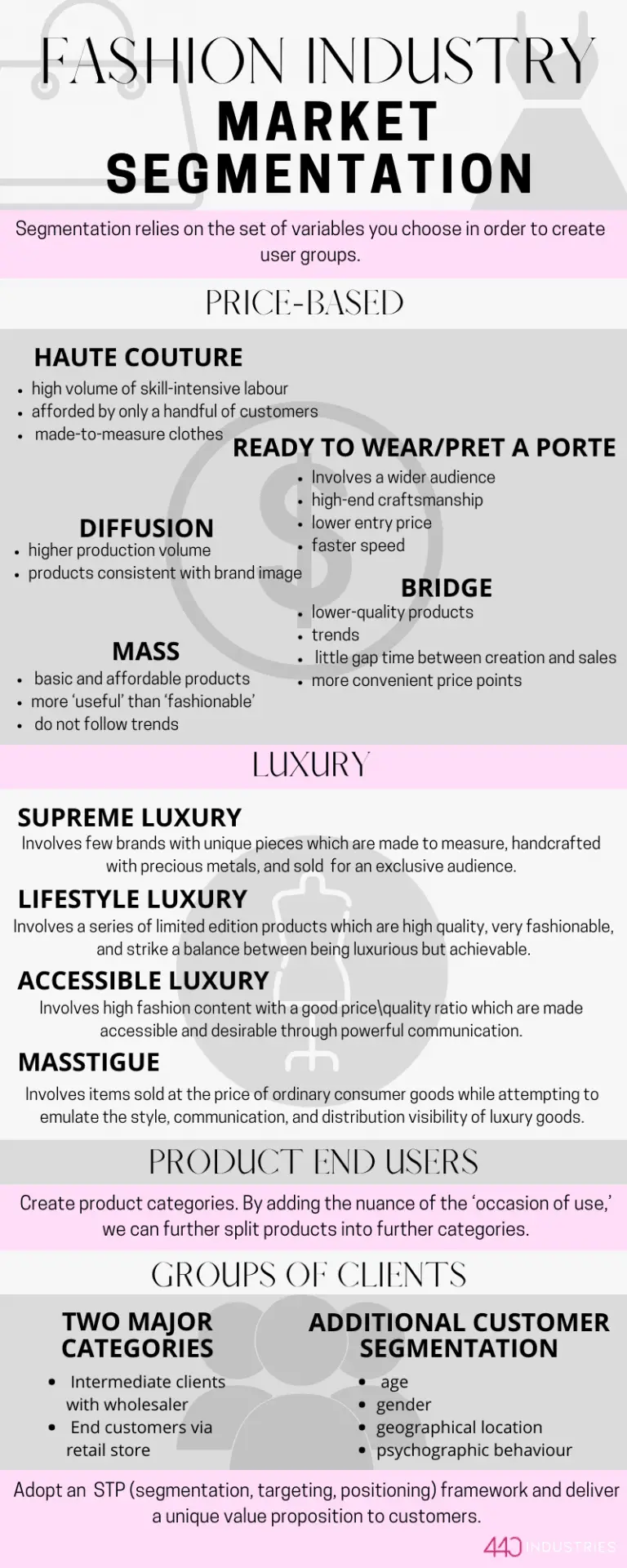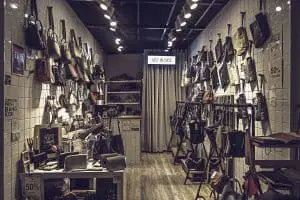Introduction
Competing in the mass-market is challenging for any company. As the saying goes, you cannot be everything to everyone, you need to pick a niche. Businesses, in fact, start developing their businesses by understanding who is the category of users they are wishing to serve. Without having a clear customer in mind every strategic decision can become very difficult to make.
The importance of understanding who ‘your business is talking to’ is echoed by the Business Model Canvas, which pushed entrepreneurs to continually question the ‘internal logic’ of their business. More about this topic can be found in this article: Understanding the Business Model Canvas.
The traditional business theory uses the so-called STP (Segmentation, Targeting, Positioning) framework to identify the ‘space’ that a brand wants to take up in their customer’s mind.
But before looking at the market, we need to focus on the fashion industry itself, in order to understand what are the different roles served by different companies in this industry. This is essential to identify who is a firm’s competitors and what are the criteria that set competitors apart.
The starting point in developing a firm’s value proposition, therefore, relies on analysing the fashion industry and breaking down its ‘players’ into ‘chunks’ with similar characteristics, behaviours and value offerings.
In this post we are going to address the following topics:
- Macro-criteria for segmenting the fashion industry
- Price-based segmentation of the fashion industry
- Luxury segmentation categories
- Masstige
- Conclusions
1. Macro-criteria for segmenting the fashion industry
Segmentation relies on the set of variables we choose in order to create user groups. We are going to discuss 3 of the most relevant segmentation criteria and what kind of opportunities they provide to the final user. Each segmentation criteria will provide us with a set variable which we’ll need to address through our business model.
- Product end users. According to these criteria, we can create product categories such as external clothing, underwear and beachwear. By adding the nuance of the ‘occasion of use’ we can further split products into further categories such as sportswear and swimwear. A particular ‘use’ will inform many decisions relative to the values that a brand wants to deliver, as an intangible added value to the product. A company like Nike, being a sportswear company created a brand attached to the value of great sportsmanship and athletic accomplishment, perfectly synthesised by the popular slogan “Just Do It”.
- Groups of clients. Groups of clients can be split into two major categories, intermediate clients and end customers. This division relates to whether firms are reaching their final consumer via a vertically-owned retail store or through wholesaler intermediation. Furthermore, end customers can be divided according to additional segmentation criteria: age, gender, geographical location, psychographic behaviour etc. As discussed in other posts such as “What The Fashion Industry Can Teach Us About Distribution and Retail”.
- Price. This can be the most immediate segmentation criteria, allowing fashion firms to identify direct price-related competitors. Creating a distinction between products on the grounds of price, allows managers to represent the fashion industry as a pyramid split into 5 tiers of price: couture, ready to wear, diffusion, bridge, mass. More about this point will be discussed later.
Fashion industry segmentation allows to compare brands, rather than products, and potentially identify what kind of value proposition is at the centre of your business model. Price and benefits, in particular, can be compared easily by breaking them down in these 5 statements:
- More for more
- More for the same
- More for less
- The same for less
- Less for much less
Pricing, according to our framework, is one of the most influential elements to inform a positioning strategy, and it should be addressed in further detail, in the next section of this post.
2. Price-based segmentation in the fashion industry
According to the price segmentation of the fashion industry, we can identify 5 segments of pricing in fashion apparel:
- Haute Couture. This segment relates to only a handful of French couturiers who are able to withstand the standards of craftsmanship required by this degree of luxury. Haute Couture involves a high volume of skill-intensive labour to create made-to-measure clothes which can be afforded by only a handful of customers globally. Haute couture, is more linked to the dream factor delivered by fashion media, then to the actual sale of the clothing itself. Haute couture could compare it to the Formula 1 segment of the automotive industry: the show factor of racing cars ‘trickles down’ to lower tiers of the automotive industry, but still ignited passion and desire into customers who may then approach much more accessible cars.
- Ready to Wear/Pret a Porter. Pret a porter is a line which was created by Italian manufacturers who wanted to create a more accessible (yet still expensive). This clothing line would expand the luxury market to a wider audience, by maintaining the high-end craftsmanship at a lower entry price. In comparison to haute couture, the speed of production and TTM (Time to Markets) is lower, as companies are able to create more collections per each year (including two main collections, a pre-collection, a cruise collection and flash collection). It has to be noted that even if the price is high, pret-a-porter it’s more fashionable than luxurious as it is more about the present than the past, it’s more up-to-date than timeless.
- Diffusion. This line is where companies try to find a sweet spot between following the trends and using fashion to make iconic statements. Fashion inspirations are derived from higher-tier categories but are produced via industrial manufacturing. In this segment key success factors include the ability of a brand to create products which are consistent with a persuasive brand image, and the ability to leverage industrial processes to create a higher production volume. As we follow the price point down, we can see how fashion media comes to ‘package’ these clothing segments with a communication strategy aimed at ‘complementing’ the products with additional service elements which help in increasing the customer perceived value.
- Bridge. This is the line of pricing usually associated with fast fashion. Despite being associated with lower-quality products, companies can still be very successful in delivering up-to-date clothing, capable of following fads and trends with little gap time between creation and sales. This is a category of products that resents from two types of competition, the tiers above, with a better quality product, and the tier below, with more convenient price points. It can be noted that in any case, fashion is a competitive industry and no segment is easy to approach.
- Mass. At this stage, products become increasingly basic and undifferentiated. In this tier, only affordable brands compete, together with private labels and unbranded products. This segment does not qualify for fashion, as the types of items sold are more ‘useful’ than ‘fashionable’ and do not resent from trends.

3. Luxury segmentation categories
If fashion apparel provides a high degree of complexity, the same can be said about the luxury industry. In this article we focus on the concept of luxury to clarify how it relates to the concept of fashion: The Value of Luxury in the Fashion Industry.
Segmentation of luxury products calls for a very articulate marketing strategy. Luxury as a concept can in itself be differentiated in several tiers:
- Supreme Luxury. This category comprehends unique pieces, which are made to measure, handcrafted with precious metals, sold – or better yet – unveiled only for an exclusive audience (e.g. Chanel). Very few brands can be ascribed to this category of products and as a result, the marketing strategies used to maintain this privileged position are usually quite unique.
- Lifestyle Luxury. In this category we find a series production (within limited editions) of products which are high quality and very fashionable, featuring heritage branding and a clear product identity, distributed selectively (e.g. Salvatore Ferragamo). This segment tries to strike a balance between being luxurious but achievable.
- Accessible Luxury. This category is for high fashion content, with a good pricequality ratio, made accessible and desirable through powerful communication (e.g. Swarowsky). As in the diffusion line for the fashion apparel segmentation, the role of communication in this category of products is focused on delivering an element of exclusivity to an otherwise widely available item.
- Masstige. The items belonging to this category are sold at the price of ordinary consumer goods, while attempting to emulate the style, communication aesthetics and distribution visibility of luxury goods (Chanel limited editions by H&M). This is a unique marketing strategy devised by fashion companies which are capable to exchange the luxury allure (Chanel) with the H&M Cool Factor.
The last category of luxury provides additional subdivisions, which we’ll look into with more detail in the next section. Masstige is in fact short for Mass-Prestige and is a unique product category which strives to hit a perfect balance between a lower-quality product and a luxury experience markup.
4. Masstige
In a society with wide-spread well-being, the desire for luxury crosses the borders of people who can actually afford a Hermés bag. Customers tend to seek self-gratification by indulging in daily pleasures, but in order to be experienced ‘daily’ price points need to stay fairly low. This sense of short-term gratification allowed for the development of products, which despite being comparable to commodities are perceived as luxury goods. This category of products is called Masstige as they share a list of similar characteristics:
Masstige products:
- Masstige products are a retail category that includes brands and products that have high-end prestigious characteristics but are sold at prices and in locations that make them accessible to mass consumers.
- Follow the blurring division between the prestige and the mass segments of the market. These product leverage the experience of owning a luxury brand, within a price range which is affordable.
- Allow for brands to deliver a fashion statement that mixes both mass-produced and prestigious clothes to obtain a mix-and-match approach. As opposed to a “total look” customers can decide to purchase a very high end, expensive items and pair them to more affordable items from ‘lower’ fashion segments.
This category of luxury, in fact, was created by studying the behaviour of rocketing consumers. Rocketing consumers trade off the purchase of lower-end products in order to buy top-tier products in other categories.
Masstige, therefore, is a product category which was created as a response to the complex relationship which is being developed between the mass market and the luxury category. Further sub-segments can be identified in the Masstige category, based on how these products interplay with customer motivations.
- Entry Lux (Entry Level Luxury): this refers to entry-level, lowest-priced models for brands normally associated with luxury, like BMW city cars. This category allows companies to have a window of opportunity to start a relationship with a customer. By establishing this connection early, the opportunity to maintain customer loyalty increases.
- Populux (Popular Luxury): low-cost consumer goods, still perceived as fashionable. Examples are H&M and Zara. In particular, in the Inditex group, we have further subdivisions, such as the brand Massimo Dutti. Another extraordinary example of this category relates to the Karl Lagerfeld limited edition collection sold at H&M, which we mentioned above. This is maybe the quintessential masstige category.
- Commodity Chic: this relates to the art of making ‘special’ a product which was once differentiated. The food industry is making this phenomenon now particularly apparent.As a result, the mass market is no longer a monolithic category. This category fulfils the need of customers to ‘reward’ themselves with an ordinary product is presented in a more appealing way.
As compared to true luxury, however, masstige brands compete primarily on communication. This is achieved by elevating the perceived value of a product by associating it with celebrities and testimonial campaigns, creating (artificially) limited editions.
Masstige does not engage with the real jet society which instead looks for an opportunity for true differentiation from any form of mass experience.
5. Conclusions
Because of what we have discussed, we can better understand how companies make use of this information to adopt an STP (segmentation, targeting, positioning) framework and deliver a unique value proposition to its customers.
Thanks to segmentation analysis fashion firms can:
- Pursue market positioning strategies
- Identify growth strategies (within a chosen market segment)
- Define what level of integration and control should be implemented in their distribution channels
- Clarify the degree of business complexity pursued by the company in order to fulfil the needs of their customer segment
- Develop new collections which are better aligned with an overarching company strategy
All in all, firms need to understand and map the associations of their brands and relate it to their market customer behaviour to inform their strategic decision-making processes.
The creation of segments allows clarifying who a firm is trying to reach, and how a fashion firm is capable to satisfy their customer personas.
Segmentation and persona-creation are a standard approach to defining a marketing strategy, however, there are also some alternative schools of thought that instead of identifying customer characteristics try to focus on their purchase behaviour. This approach is called ‘ Jobs to Be Done ‘ and is addressed in this further source: Why Jobs to Be Done Matters for your Business.
Now that we’ve identified our customer, we need to build a business model around himher and determine the business logic our firm is going to pursue. To move ahead, here’s the next stage in our journey: Identifying Business Models in the Fashion Industry.
If you’re interested in learning more about the Fashion Industry, don’t hesitate to take a look at our course “The Fashion Industry: Explained”. Our in-depth class covers a wide range of topics spanning from understanding fashion customers and markets to developing immersive retail experiences for your customers. Here’s a link to the course, if you use the discount code BLOG20 you can access a 20% discount. Enjoy!







